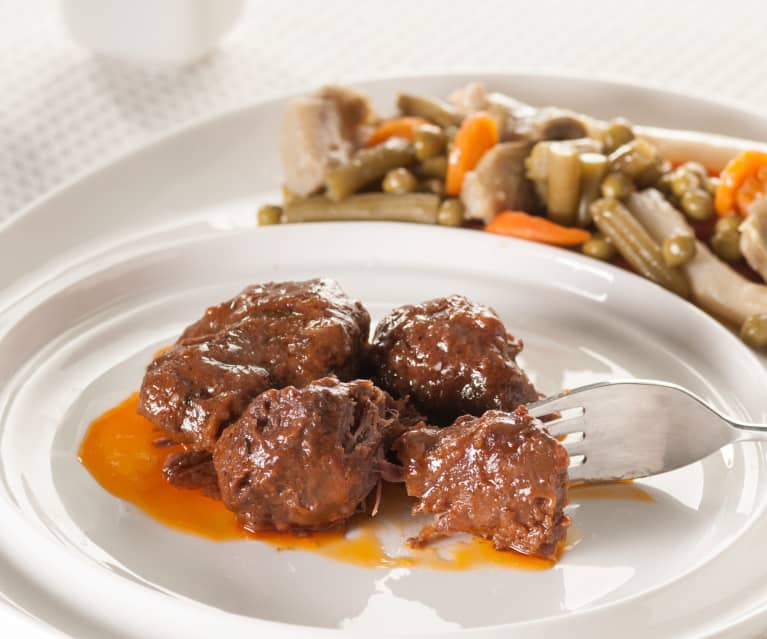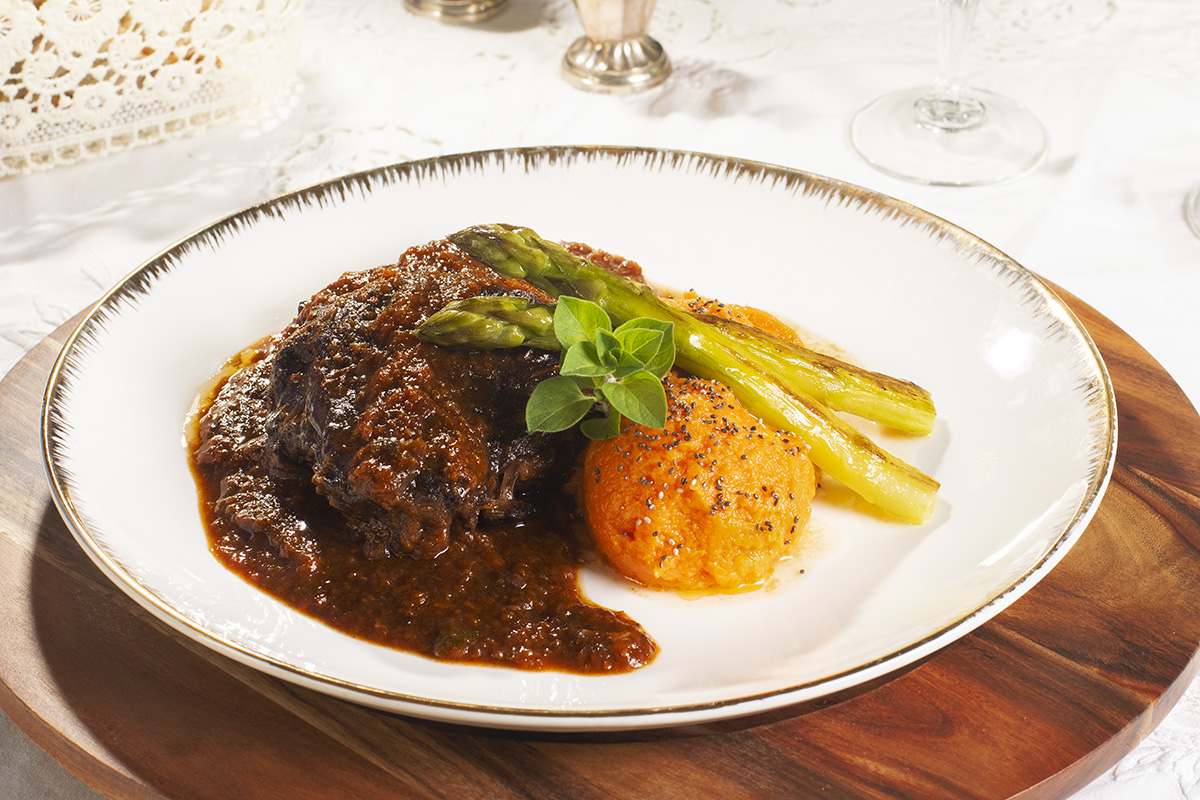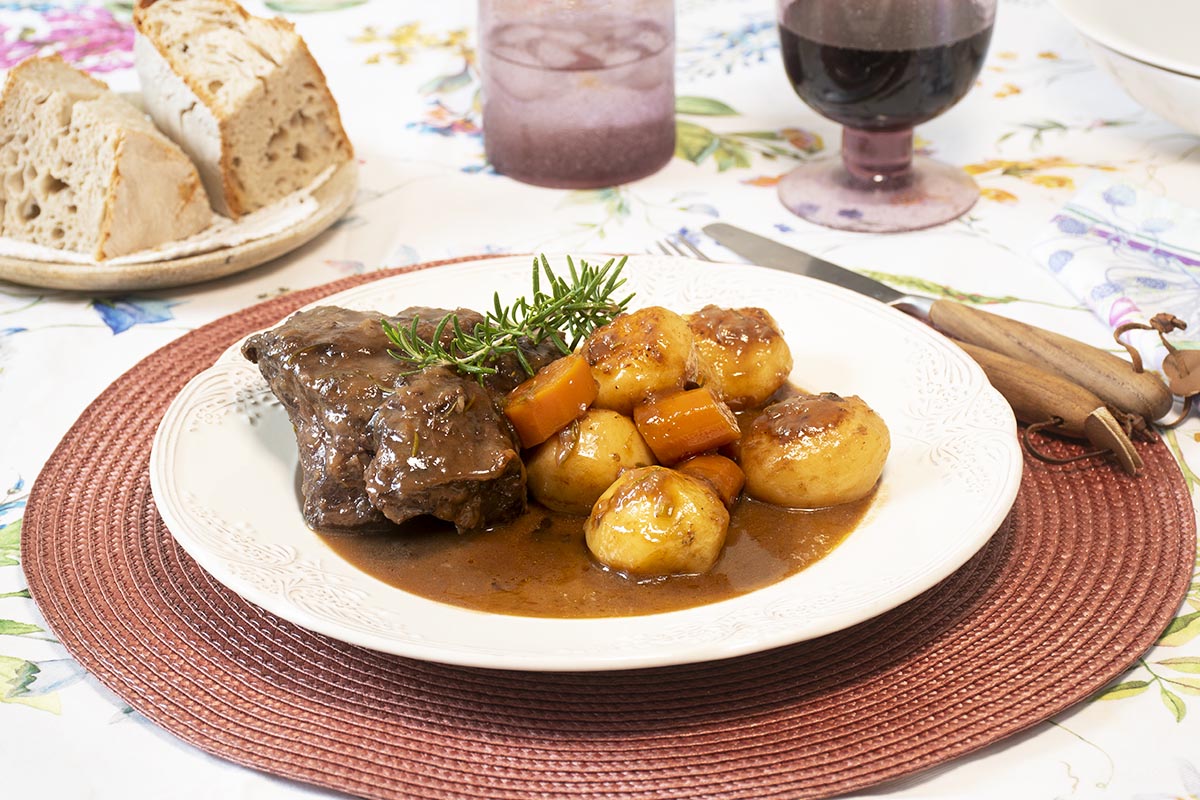During an unforgettable journey through the vibrant landscapes and the pulsating heart of Spanish culture, I was fortunate enough to uncover the culinary treasure known as Carrillada. This dish, a testament to the simplicity and richness of Spanish cuisine, features tender pork cheeks slowly simmered in a savory beef stock, accompanied by the hearty comfort of potatoes. The combination of succulent pork cheeks, robust beef stock, and gently cooked potatoes creates a harmony of flavors and textures that speaks to the soul of traditional Spanish cooking. Captivated by this discovery, I was driven to master the art of preparing Carrillada within the confines of my own kitchen. With persistence and a deep appreciation for the ingredients and their intricate flavors, I succeeded in capturing the essence of this beloved Spanish dish. It is with immense pleasure and pride that I now share this recipe with you, inviting you to partake in the rich, comforting flavors of Carrillada, and bring a piece of Spain’s culinary legacy into your home.

Carrillada
Equipment
- 1 heavy pan
Ingredients
- 1/3 cup extra virgin olive oil
- 3 cups of beef stock
- Salt and pepper to taste
- 2 tablespoons of flour
- 12 Iberian pork cheeks
- 1/2 teaspoon thyme
- 1/2 teaspoon parsley fresh
- 1 bay leaf
- 2 tablespoons of honey
- 2 cups of port wine
- 24 fingerling potatoes
- 1 onion
- 1 red pepper
- 2 cloves of garlic
- 1 green apple
- 2 carrots
- 6 shallots
Instructions
- In a pestle and mortar, crush the garlic with the herbs, sugar, parsley, and a pint of oil.
- Allow the pig cheeks to soak the spices for approximately an hour before dredging them in flour.
- In a heavy pan over medium-low heat, heat the oil.
- Cook the pork cheeks on both sides until they are golden brown.
- Take each cheek from the pan once it has been seared and set aside.
- The onions and red peppers should be diced into tiny pieces.
- Cut the onions in half after peeling them.
- Cook the onions, peppers, onions, and ginger for fifteen minutes over low heat.
- Cook the carrilladas in the beef stock for approximately 1.5 hours over medium heat until they are fully soft.
- Add the garlic and apple to the pot for twenty minutes until pulling it off the heat.
Cooking tips about Carrillada

- Selecting Pork Cheeks: The star of Carrillada is, without question, the pork cheeks. This cut of meat is known for its tenderness and flavor. Look for fresh, high-quality pork cheeks from a trusted butcher to ensure the best base for your dish.
- Trimming the Meat: Although pork cheeks are a relatively lean cut, they may come with some connective tissue. Take the time to trim off any excess fat or sinew to ensure a more pleasant texture in the final dish.
- Browning is Crucial: Before slow cooking, sear the pork cheeks on all sides in a hot pan with a little oil. This step is essential for developing a deep, rich flavor in the meat and contributing to the sauce’s complexity.
- Low and Slow Cooking: Carrillada benefits immensely from being cooked gently over a low heat for several hours. This slow cooking process allows the pork cheeks to become incredibly tender, almost melting in your mouth, while also allowing the flavors of the sauce to become more concentrated and infused into the meat.
- Rich Beef Stock: Use a high-quality beef stock as the base of your cooking liquid. The robust flavor of the stock will complement the pork cheeks and help create a deeply savory sauce that ties the whole dish together.
- Adding Flavor Depth: Besides beef stock, integrating other elements like red wine, onions, garlic, carrots, and a bouquet of herbs (such as thyme and bay leaves) can add layers of flavor to your Carrillada. A splash of brandy or sherry can also introduce a subtle complexity that enhances the dish.
- Sauce Consistency: After the meat is tender, you might find you want to adjust the thickness of your sauce. If it’s too thin, remove the cheeks and reduce the sauce to your preferred consistency. If it’s too thick, adding a bit more stock can thin it out.
- Final Seasoning: Before serving, taste the sauce and adjust the seasoning with salt and pepper as needed. Balancing the flavors at this stage ensures a perfect harmony in the completed dish.
- Resting Before Serving: Let the Carrillada rest for a few minutes after cooking and before slicing or serving. This allows the juices to redistribute, ensuring that every bite is succulent.
- Serving Suggestions: Carrillada pairs beautifully with simple sides that can absorb its rich sauce, such as mashed potatoes, polenta or a creamy risotto, and even traditional Spanish-style rice.
Serving suggestions about Carrillada

- Rustic Sides: Pair Carrillada with rustic, comforting sides such as mashed potatoes or a creamy polenta. These not only serve as the perfect backdrop for the succulent pork cheeks but also beautifully absorb the savory sauce that accompanies the meat.
- Seasonal Vegetables: Lightly sautéed or roasted seasonal vegetables can add color and a hint of freshness to balance the richness of the dish. Consider options like asparagus in spring or roasted root vegetables in the winter for a side that complements the main without overshadowing its flavors.
- Spanish Inspired Grains: For a truly Spanish touch, serve Carrillada with a side of Spanish rice or a simple saffron-infused risotto. The subtle spices will harmonize with the robust flavors of the sauce while adding a different texture to the meal.
- Bread for Dipping: Offering slices of crusty bread on the side is essential for sopping up any remaining beef stock-infused sauce. This ensures that none of the delicious, deeply flavored sauce goes to waste.
- Wine Pairing: A dish with the depth and complexity of Carrillada deserves a wine that can stand up to its flavors. Consider serving it with a full-bodied red Spanish wine, such as a Rioja or a Tempranillo, which can complement the richness of the pork cheeks and the savoriness of the beef stock.
Top 5 FAQs about Carrillada

- What is Carrillada? Carrillada is a celebrated dish in Spanish cuisine focusing on pork cheeks as the primary ingredient. This delicacy is known for its tenderness and flavor, achieved through slow simmering in beef stock, making it a staple for those who appreciate the heritage and depth of Spanish cooking traditions.
- What makes the pork cheeks special in Carrillada? Pork cheeks are prized in Carrillada for their texture and taste. When cooked slowly and with care, pork cheeks become irresistibly tender and rich in flavor, embodying the dish’s essence. Their ability to absorb the savory nuances of the stock and seasonings used in the cooking process enhances the overall gastronomic experience.
- How should Carrillada be cooked to achieve optimal results? Carrillada reaches its full potential when simmered low and slow over several hours. This method allows the meat to soften, falling apart tenderly while absorbing the flavors of the beef stock and any added herbs, wine, or vegetables, creating a harmonious balance between the succulence of the pork cheeks and the savory depth of the sauce.
- What are the best sides to serve with Carrillada? To complement Carrillada, consider serving it with sides that can soak up its rich sauce, such as mashed potatoes, polenta, creamy risotto, or traditional Spanish-style rice. These sides not only enhance the dish’s comforting aspect but also highlight its sophistication.
- Can Carrillada be prepared at home, and is it easy to replicate the authentic Spanish flavor? Yes, Carrillada can be confidently recreated at home by adhering to specific cooking tips outlined in the context, such as selecting high-quality pork cheeks, browning the meat before slow cooking, and using a robust beef stock as the cooking liquid. Incorporating additional flavors through vegetables, herbs, and a splash of brandy or sherry can bring one closer to achieving an authentic Spanish flavor, inviting enthusiasts to explore the subtleties of Spain’s culinary culture in their own kitchens.

Leave a Reply